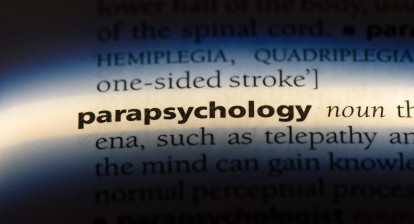In the September 2007 issue of the British Journal of Social Psychology, a paper reporting findings from a conversational analytic study of experimenter-participant interactions in parapsychology experiments was presented by Dr. Robin Wooffitt, a senior lecturer in the sociology department at the University of York. In the paper, Dr. Wooffitt discusses how the ways in which experimenters acknowledge participants utterances may be significant for the trajectory of an experimental session.
Dr. Wooffitt used recorded sessions from double-blind ganzfeld experiments conducted in the mid 1990’s at the Koeslter Parapsychology Unit (University of Edinburgh) as the material for his analysis. Shortly after the study appeared in print, the BPS Research Digest released a summary at their blog, suggesting that Dr. Wooffitt had uncovered a flaw in the ganzfeld. This summary spread through the internet like wildfire. Soon the blogs Mind Hacks and Science and Consciousness Review were also reporting on the study, suggesting that Dr. Wooffitt had provided an analysis that had explained away the positive results of those ganzfeld experiments. Anybody who does a close reading of the paper (or even the abstract) can see that this is not the case.
Because Dr. Wooffitt’s research had been severely misrepresented by these and other sites, I contacted him and invited to discuss his research and its goals here at Public Parapsychology. The following was his response:
“There seems to be some confusion about the purpose and results of my on-going research on verbal interaction in ganzfeld parapsychology experiments. This is due to a misleading summary on the website of the British Psychological Society of an article I published in one of the Society’s journals (Wooffitt, R. (2007) ‘Interaction and laboratory experience: observations from parapsychological data.’ British Journal of Social Psychology. 46(3) 477-501). This summary was written without my knowledge and with no input from me. It gave the impression that the analysis presented in the paper stands as sceptical critique of the ganzfeld. When Annalisa drew my attention to the website summary I contacted the BPS immediately and asked for it to be withdrawn and rewritten, which it was. However, Annalisa has kindly allowed me to provide a brief account of the history and goals of the research in case there is any lingering misunderstanding.
My research concerns, broadly, the relationship between language and anomalous experiences. For example my PhD (part funded by the Society for Psychical Research) was a study of how people describe spontaneous experiences. Round about 2000, I became interested in interaction in parapsychology laboratories. I was able to spend 2001-2 as a Visiting Fellow in the Koestler Parapsychology Unit at the University of Edinburgh. The then head of the Unit, Professor Bob Morris, kindly provided access to some of the KPU ganzfeld data, and, with support from the Bial Foundation, I have been working on these data since (in amongst other projects).
The goal of the research is to identify the tacit communicative skills which participants – experimenters and subjects – use in the ganzfeld. The research is agnostic as to the existence of psi; but it may identify features of experimenter-subject interaction which could be of direct benefit for parapsychologists. So, this kind of linguistic analysis can add to our knowledge of the experimenter effect, in that it can provide technical analysis of the way the relationship between subject and experimenter develops over the course of a ganzfeld trial. It can identify different interactional styles in experimenters, which may in turn influence the way the experiment progresses. It may be possible, eventually, to see if particular interactional practices correlate with successful or unsuccessful ganzfeld trials.
When I publish the findings from this research in social science journals, it is important to address concerns that are relevant to their audiences (otherwise they wouldn’t get published). The main focus of the paper that was summarised so badly, for example, used the parapsychology data to explore broader aspects of the interpersonal dynamics of laboratory practice, an issue that is important in social psychology. But when I publish in mainstream social science journals, I try to include a review of the efforts of parapsychologists and the results of their work. This way, academic audiences who have no knowledge of parapsychology are at least exposed to what I hope are balanced accounts of serious scientific investigation into anomalous experiences.”
Anyone interested in this work can consult the article in the British Journal of Social Psychology, or any of the following:
Allistone, S. and Wooffitt, R. (2007) ‘Negotiating consciousness: parapsychology and the social organisation of reports of mental states’ in A. Hepburn and S. Wiggins (eds.)Discursive Research in Practice: New Approaches to Psychology and Interaction. Cambridge: Cambridge University Press, 70-87.
Wooffitt, R. (2005) ‘Language and the study of parapsychological phenomena’ in M. A. Thalbourne and L. Storm (eds.) Parapsychology in the 21st Century : Essays on the Future of Psychical Research. North Carolina and London: McFarland, 305-336.
Wooffitt, R., and Allistone, S. (2005) ‘Towards a discursive parapsychology: language and the laboratory study of anomalous communication.’ Theory and Psychology 15:3, 325-355.
Wooffitt, R. (2003) ‘Conversation analysis and parapsychology: experimenter-subject interaction in ganzfeld experiments.’ Journal of Parapsychology. 67: 299-324.







